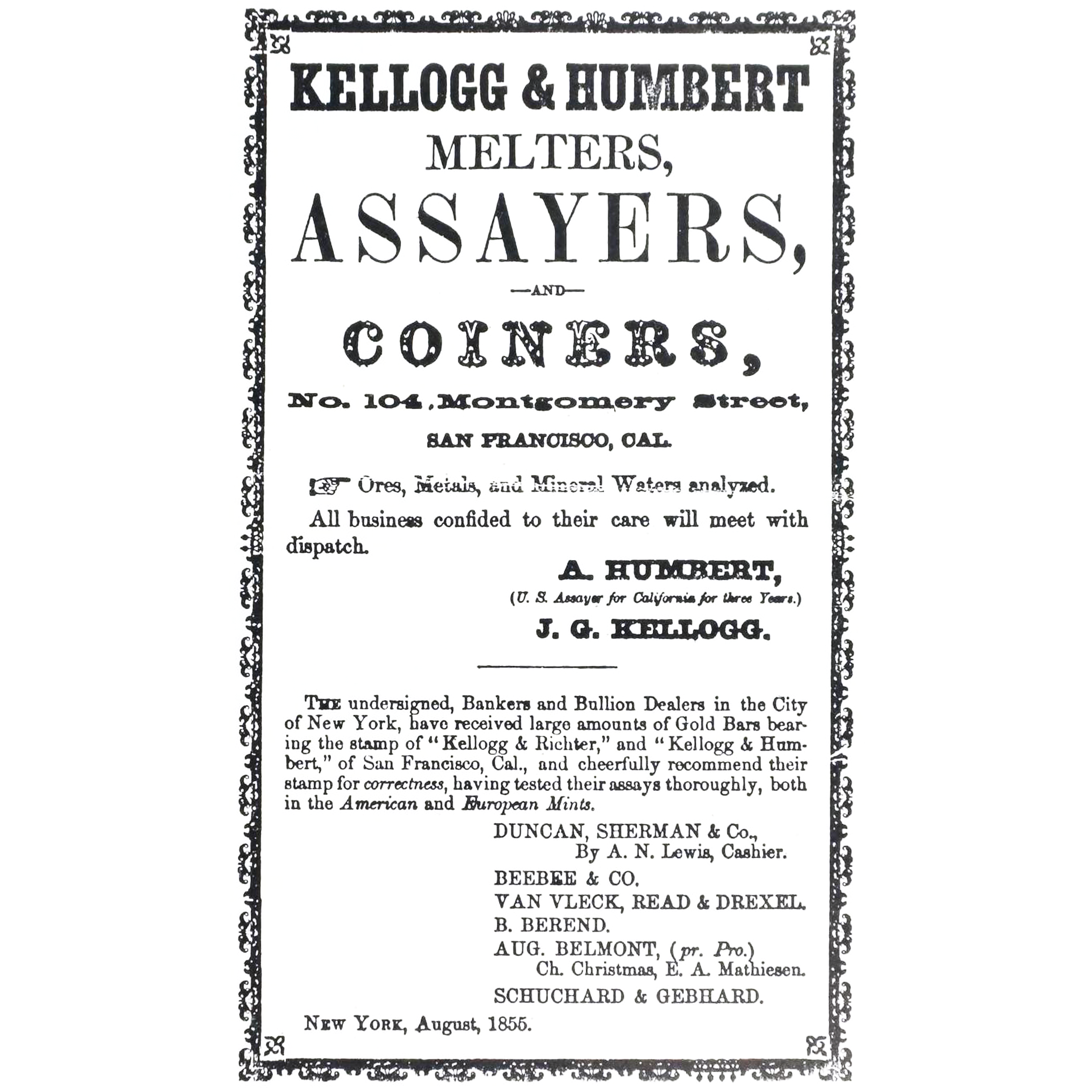A late entry in the field of private coinage was Kellogg & Co. of San Francisco, which produced its first coins in 1854.
John Glover Kellogg, of Auburn, New York, came to San Francisco on October 12, 1849. He secured a position with Moffat & Co. and remained with them during the operations of the United States Assay Office of Gold. When the latter institution discontinued business on December 14, 1853, Kellogg formed a new partnership with G. F. Richter, who earlier had worked with the United States Assay Office as an assayer. On December 19, 1853, the San Francisco Herald carried this advertisement:
ASSAY OFFICE. The undersigned, who have been connected with the United States Assay Office from its commencement, have opened an office for melting and assaying gold in the basement of J. P. Haven's Building, 106 Montgomery St., one door from Lucas, Turner & Co.'s banking house and nearly opposite Adams & Co.
Kellogg & Richter
Appended to the advertisement was an endorsement by Augustus Humbert:
Messrs. Kellogg & Richter have been employed, the former as cashier and the latter as practical assayer, in the United States Assay Office from its commencement to its close. We take pleasure in bearing testimony to their industry, integrity, and skill, and in commending them to the confidence and patronage of the public.
Curtis & Perry
A. Humbert, Late U.S. Assayer.
On January 14, 1854, a number of leading banking houses of San Francisco and Sacramento addressed a petition to Kellogg & Richter imploring them to produce coins, in the period after which the United States Assay Office of Gold had ceased operations and before the United States Mint at San Francisco had begun. The merchants indicated their willingness to receive any coins that would be produced. Kellogg & Richter replied on January 31, 1854:
Your letter under date of Jan. 14th, requesting us to issue our own private coin, is at hand. We shall be able to comply with your request ten days from this date. With many thanks for your expressions of confidence in our abilities as assayers, and in our integrity, we remain,
Yours truly, Kellogg & Co.
On February 9, 1854, the first Kellogg coin was issued, as evidenced by a notice which appeared in the February 15, 1854 issue of Alta California:
Messrs. Kellogg & Richter have established a private coining house on Montgomery St., in the basement of the building adjoining Adams & Co.'s old banking house. They issued their first coin on the 9th. It is like a United States coin, except that in place of LIBERTY are the words KELLOGG & CO. They expect to be able to issue $20,000 per day.
An observation concerning this situation was made on February 15, 1854 by San Francisco Prices Current:
We have to notice that the alterations of the old Assay Office of Curtis, Perry & Ward are progressing well, the additions and changes being by virtue of contract for the erection of the United States Mint Buildings and the supplying of suitable machinery. To supply any deficiency or vacuum which may arise before the Mint can commence operations, or indeed afterward, we have to notice that Messrs. Kellogg & Richter, assayers, have commenced the issue of private coins, the first pieces of this stamp, "Kellogg & Co." having made their appearance this week, and of the denomination $20. They are similar in their general style to the United States coins, but easily distinguishable by their yellow appearance, which is the natural color of California gold, while the peculiar appearance of the regular double eagle [reference to the United States Mint issue] is the result of copper alloy.
Following the opening of the San Francisco Mint production at the government facility was quite limited. Kellogg & Co. therefore did a large business by continuing their private coinage. Toward the end of 1854 the firm of Kellogg & Richter was dissolved and a new firm, Kellogg & Humbert took its place, with Augustus Humbert, formerly the United States Assayer, joining. This partnership continued until 1860, although the last coins were struck in 1855.

On May 1, 1855 Alta California noted Kellogg & Co. was producing a quantity of coins vastly greater than the United States Mint in the same city. It noted that about $1.5 million was the largest coinage per month from the Mint, whereas Kellogg & Co. for many weeks made from $60,000 to $80,000 worth of coins per day.
Adams noted that Kellogg & Co. was credited with having produced $6 million worth of $20 gold pieces during its time, and that a large number of these were lost "by the sinking of a steamer in the Pacific on its way from San Francisco to New York."
The most impressive Kellogg & Co. piece is a large $50 coin, of round shape, bearing on the obverse the head of Liberty, with a Kellogg inscription, and on the reverse a standing eagle. Adams noted that:
This represents one of the handsomest pieces of die cutting in the entire California series. No information concerning this Kellogg $ 50 piece seems to be attainable. It is quite certain, however, that it was issued at the same time as the Wass, Molitor & Co. pieces of the same value, and like the latter, owes its origin to the demand of San Francisco merchants for gold pieces of larger denominations for quick counting purposes.







